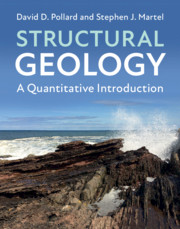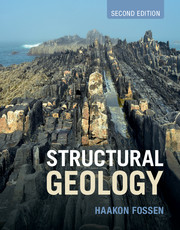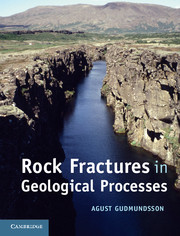Structural Geology
A Quantitative Introduction
- Authors:
- David D. Pollard, Stanford University, California
- Stephen J. Martel, University of Hawaii, Manoa
- Date Published: July 2020
- availability: Available
- format: Hardback
- isbn: 9781107035065
Hardback
-
Tackling structural geology problems today requires a quantitative understanding of the underlying physical principles, and the ability to apply mathematical models to deformation processes within the Earth. Accessible yet rigorous, this unique textbook demonstrates how to approach structural geology quantitatively using calculus and mechanics, and prepares students to interface with professional geophysicists and engineers who appreciate and utilize the same tools and computational methods to solve multidisciplinary problems. Clearly explained methods are used throughout the book to quantify field data, set up mathematical models for the formation of structures, and compare model results to field observations. An extensive online package of coordinated laboratory exercises enables students to consolidate their learning and put it into practice by analyzing structural data and building insightful models. Designed for single-semester undergraduate courses, this pioneering text prepares students for graduates studies and careers as professional geoscientists.
Read more- Presents a rigorous quantitative approach to structural geology balanced with description and geological examples from the field
- Complemented by a website hosting a wealth of supplementary teaching resources, including a lab manual of practical activities and computational MATLAB exercises that help develop programming skills
- Illustrated throughout in full color, with electronic figures available to instructors and MATLAB® scripts for solving problems and recreating model plots, and worked problems that offer examples of how to address questions in structural geology
- Assumes one year each of college-level physics and calculus
Reviews & endorsements
'This textbook is an excellent introduction to quantitative structural geology, showing the formation of structures using both calculus and mechanics. The book bridges the gap between descriptive structural geology books and more advanced textbooks requiring a continuum mechanics background, and will be a 'must' for all geoscientists who wish to learn how to interpret geological structures based on fundamental physical principles.' Bernhard Grasemann, University of Vienna
See more reviews'Pollard and Martel have written the 'Turcotte and Schubert' of structural geology. Their treatment, focusing on quantitative analysis of canonical examples, is unique, and their respect for structural geology is demonstrated by copious use of maps and field examples. The text is suitable for upper-level undergraduates with a strong math or engineering background, and is essential for all graduate students and professors of structural geology.' Richard Allmendinger, Cornell University
'This textbook tackles head-on the difficult task of quantifying the deformation processes operating in the Earth's crust in a manner that can be understood by readers without a strong mathematical background. Clearly written and beautifully illustrated with a plethora of useful and interesting diagrams and photographs - the authors are to be congratulated on producing a book that will become one of the standard structural texts for the next decade.' John Cosgrove, Imperial College London
'This is a great book! … recommend to the students in volcanology.' Janine Kavanagh, University of Liverpool
Customer reviews
Not yet reviewed
Be the first to review
Review was not posted due to profanity
×Product details
- Date Published: July 2020
- format: Hardback
- isbn: 9781107035065
- length: 450 pages
- dimensions: 284 x 228 x 25 mm
- weight: 1.5kg
- availability: Available
Table of Contents
Contents
List of Boxes
Preface
1. Scope of Structural Geology
2. Mathematical Tools
3. Physical Concepts
4. Elastic-brittle Deformation
5. Elastic-ductile Deformation
6. Elastic-viscous Deformation
7. Fractures
8. Faults
9. Folds
10. Fabrics
11. Intrusions
References
Index.
Sorry, this resource is locked
Please register or sign in to request access. If you are having problems accessing these resources please email [email protected]
Register Sign in» Proceed
You are now leaving the Cambridge University Press website. Your eBook purchase and download will be completed by our partner www.ebooks.com. Please see the permission section of the www.ebooks.com catalogue page for details of the print & copy limits on our eBooks.
Continue ×Are you sure you want to delete your account?
This cannot be undone.
Thank you for your feedback which will help us improve our service.
If you requested a response, we will make sure to get back to you shortly.
×






